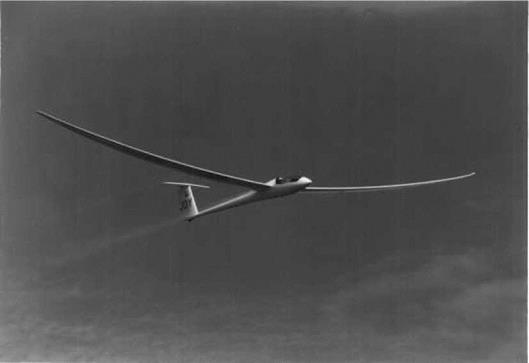Dihedral Effect of a Flexible Wing
Dihedral effect Cle, the rolling moment due to sideslip, is determined chiefly by wing dihedral. However, the dihedral angle of airplanes with flexible wings varies noticeably according to the wing’s lift loads. Wing tips that droop when an airplane is parked can rise above the wing roots in flight, creating a positive dihedral angle. High-performance fiberglass sailplane wings bend upward alarmingly in flight, especially when the sailplane is in high-load-factor turns or pullups (Figure 19.7).
The first published analysis of the additional dihedral effect due to load factor showed a near doubling of dihedral effect for a wing of aspect ratio 10, at a hypothetical airplane’s limit load factor of 4.0. (Lovell, 1948). In a later published analysis of this effect, W. P. Rodden showed that measured aeroelastic effects on a flexible model of the Douglas XA3D-1 could be correlated with a simple theory that assumes a parabolic distribution of wing bending
|
Figure 19.7 Upward bending under airload of the flexible wings of a high-performance fiberglass sailplane. The bending adds to its effective dihedral angle. (Photo by Steve Hines) |
(Rodden, 1955). This leads to a linear asymmetric spanwise distribution in additional angle of attack, as for the pure rolling case. An approximation to the flexibility increment to Cle is thus proportional to well-known roll damping derivative Clp values.
Rodden’s 1955 simplified analysis considers only the effects of symmetric air loads on wing bending. The analysis was extended to include the effects of asymmetric air loads (Rodden, 1965). Asymmetric loads cause an amplification of the dihedral angle. Matrix methods are used in this case, with aerodynamic and structural influence coefficients (Figure 19.8).












